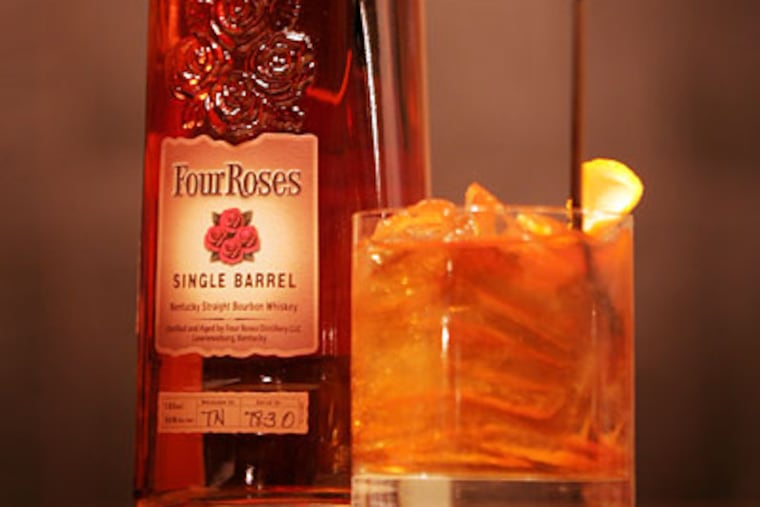A new Four Roses blossoms on palates
Old-timers can be forgiven their double-takes at the sudden reemergence of Four Roses bourbon on the top shelf at trendy local bars, and at the single-barrel heart of $14 cocktails.

Old-timers can be forgiven their double-takes at the sudden reemergence of Four Roses bourbon on the top shelf at trendy local bars, and at the single-barrel heart of $14 cocktails.
Those veteran drinkers might well remember Four Roses whiskey - but not necessarily in a good way. If they didn't see its famous flower-decked yellow label on the bottom rung at a liquor store, they'd see it on the street - rolling around empty in a brown paper bag, a favored bottle for skid-row swillers.
What they are recalling, though, is not the notable new Four Roses being sold today. It wasn't even bourbon. It was, instead, a "blended whiskey" impostor of neutral grain spirits that was sold exclusively in the United States from 1960 to 2001, while parent company Seagrams built the genuine Kentucky bourbon into a best-seller for its European and Japanese markets.
Master distiller Jim Rutledge, who has led Four Roses' impressive comeback as a standout bourbon in the last eight years, can only nod in quiet disgust at that unfortunate episode for one of America's great whiskey brands. It's a name that dates back to the 1860s and was once the country's best-selling bourbon after Prohibition until Seagrams bought it.
It wouldn't begin to reclaim that glory, though, until Seagrams ceased to exist in 2001 and the brand was bought by Kirin, the Asian brewing giant that knew very well, from Four Roses' popularity in Japan, the potential of the brand.
"The quest in earnest to bring Four Roses bourbon home," Rutledge said, "became a burning passion."
Although its return to the Pennsylvania market is very recent, it didn't take long for the rejuvenated Four Roses to make a critical impact nationally. The exquisite single-barrel version was named "Best American Whiskey" by Whiskey Magazine in 2005. By 2006, it was already the top-selling single-barrel bourbon in Kentucky, says Rutledge.
In Philadelphia now, it's a new fixture at numerous bars (Oyster House, Khyber Pass) and is one of the favored spirits at Jose Garces' restaurants, which bought an entire barrel (about 136 bottles) to be used in snifters and cocktails at Village Whiskey and JG Domestic.
The appeal is easy to understand. For the quality, Four Roses' array of bourbons are still extremely affordable, ranging from $18.99 for the entry-level Yellow Label to $39.99 for the single-barrel. But the whiskey itself is also unique, with a "high-rye" character to the brew that lends it a spicier flavor than most of its competitors.
Most bourbon distillers craft their range of whiskeys from a single recipe and barrels that draw flavor variations from the different temperature zones of tall, hot "rick houses" for aging. Four Roses' aging houses are comparatively low and consistent in temperature, but the distillery actually makes 10 different spirits by mixing and matching two different mash recipes with five proprietary yeasts.
According to author Dave Broom's new The World Atlas of Whiskey (Mitchell Beazley, 2010), these different yeast strains produce flavors ranging from violet and spice to ripe fruit, jasmine or bananas, and yes, even roses, allowing "Professor" Rutledge, he writes, to "revel in complexity."
The Small-Batch and the Single-Barrel are essentially made from entirely different whiskeys. The Yellow Label is a blend of all 10. And at a recent private tasting, I found each to have endearing charms. The Single-Barrel was my personal favorite, a high-end snifter of deep-amber persuasion that is remarkably smooth for 100 proof, with oaky vanilla and caramel, a lingering hint of cherry and orange peels rolled around a burst of yeasty biscuit.
No wonder it's such a fantastic fit for the Empire Builder, a signature cocktail at JG Domestic that blends in actual orange peels plus a few dashes of house-made espresso-and-chicory bitters (steeped on torched cherrywood chips), a counter to the rye spice that is a brilliant touch.
The "small batch," currently not available retail in Pennsylvania, is blended from 17 to 18 barrels and uses less rye than the single-barrel, so it's more sedate, allowing a nice, nutty halo of English toffee to shine through.
It was the Yellow Label, though, that struck me most. Deceptively light at 80 proof, and blended from all 10 recipes, it drinks like honeyed lemon. Dangerously smooth.
If there's a way to speed an image makeover, and introduce an entirely new generation to a brand's rightfully more glorious tradition, that's exactly how to do it.
nolead begins
The Empire Builder, at JG Domestic
Makes one drink
11/2 ounces Garces Four Roses Single
Barrel
1/4 ounce Averna Amaro
8 dashes of our house coffee bitters
2 teaspoons Demerara sugar
2 fresh orange peels
Blend ingredients with a little ice and stir for two minutes (adding additional ice gradually) to mellow and lightly dilute the drink. Strain and pour over fresh ice in a rocks glass, adding orange peels.